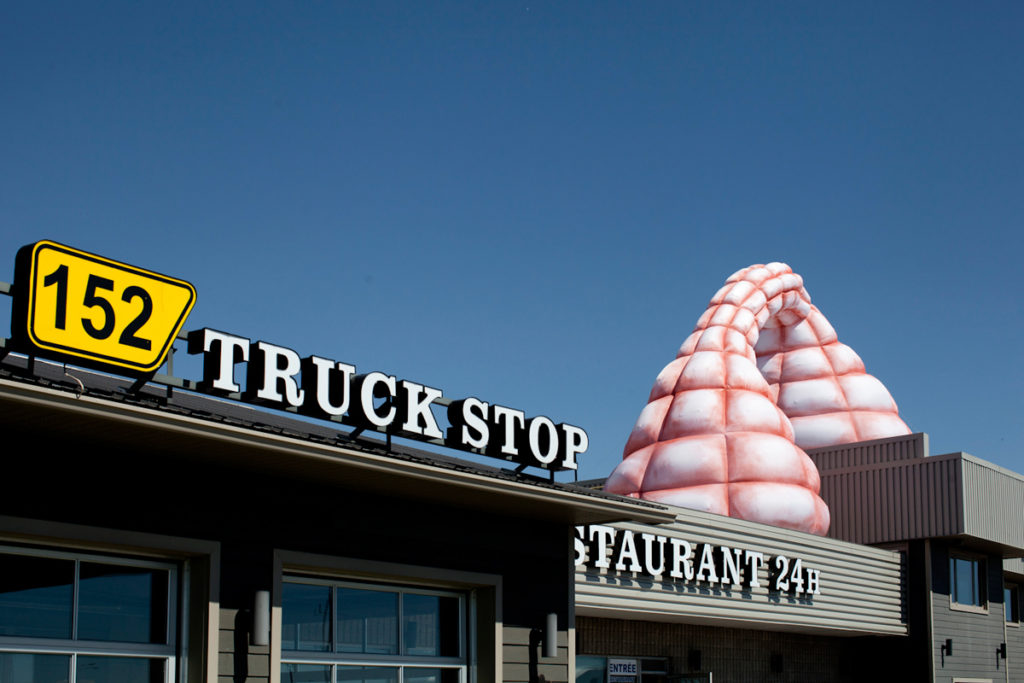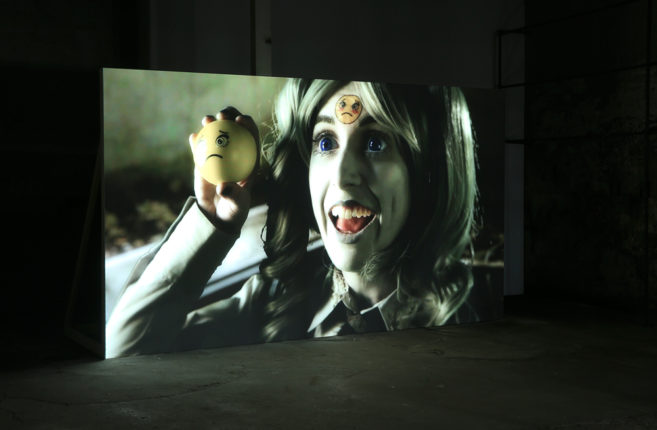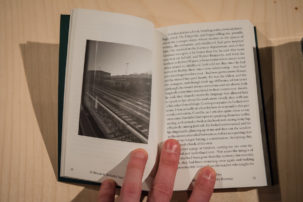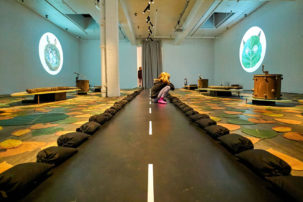The backbone of Quebec’s heartland was once the St. Lawrence River, but today the river must forfeit that distinction to Route 20, the stretch of the Trans-Canada Highway linking Montreal and Quebec City. Known locally as Autoroute Jean-Lesage, after Quebec’s 19th premier, this two-and-a-half hour drive is familiar, even iconic, for most Quebeckers. The 20 even boasts its own road movie, Québec–Montréal, directed by Ricardo Trogi in 2002, which, if highways had a hierarchy, would make it at least a minor aristocrat.
Marking the cultural life of this thoroughfare, Montreal’s Centre Clark and Quebec City’s l’Œil de Poisson have co-produced “Truck Stop,” ma an exhibition of works by 15 artists and collectives that is situated along the autoroute between the two cities. The collaboration, the result of two years of coordination and planning, is “a way for artists to present their work in new contexts and for new publics,” according to Roxanne Arsenault, Centre Clark’s general and artistic director, programming. Crossing two provincial transport jurisdictions and involving several private property owners, the project is also, frankly, a huge achievement in collaboration for a pair of artist-run centres.
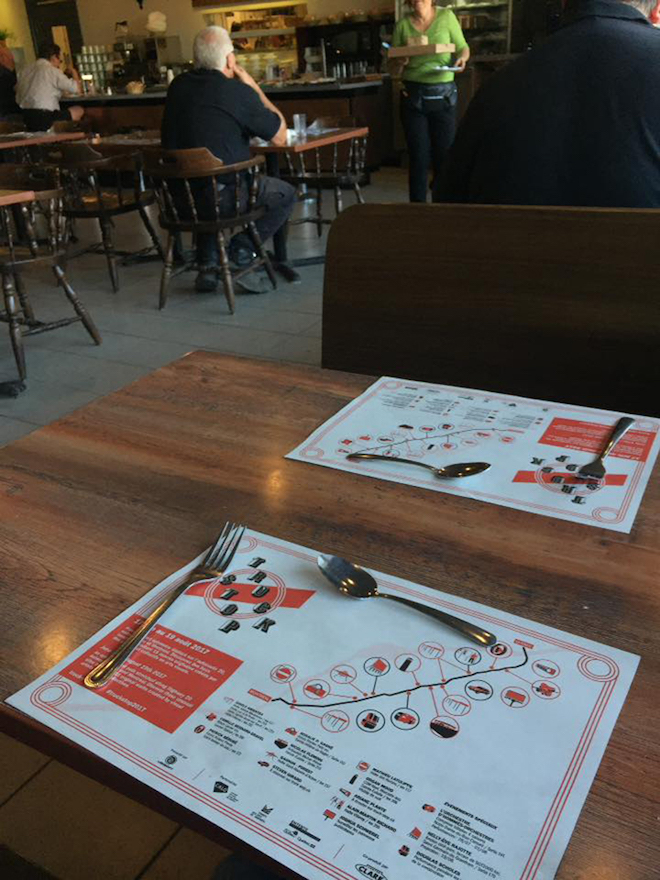 Maps for “Truck Stop,” in the form of placemats, were distributed to restaurants along Autoroute 20. Photo: via Truck Stop Facebook page.
Maps for “Truck Stop,” in the form of placemats, were distributed to restaurants along Autoroute 20. Photo: via Truck Stop Facebook page.
Typical of the St. Lawrence River Valley, the country along the 20 is humid, green and flat, intruded upon occasionally by round-topped Monteregian Hills—but the natural world mostly fades into the background. The motor vehicle, along with its accoutrements and infrastructures, plays the starring role here: overpasses, ramps, cloverleafs and the corporate lexicon of the big rig: Robert, Piché, Purolator, Transbocop, Guilbault, Erb. Vast parking lots are filled with phalanxes of vehicles for sale: camper vans at Roulottes A. S. Lévesque near Sainte-Hélène-de-Bagot … red-and-white semi-trailer rigs at Guay near Beloeil … endless yellow school buses at Girardin in Drummondville
The occasional blast of weirdness—giant dinosaur statues at Le Madrid, for example, a garish truck stop on the Rivière Nicolet south of Saint-Léonard-d’Aston—recalls Umberto Eco’s description of the North American road as a “hyperreal” space. Against this backdrop, the profound natural beauty of the Rivière Saint-François, which one crosses at Drummondville, is somewhat jarring and all too brief.
In a show where one expects signage and billboard art, only a project or two are of this kind. Joshua Schwebel’s Campaign features advertisements from some of Quebec’s largest contemporary art institutions, normally deployed in urban contexts, on billboards along the 20. Making an art form out of institutional critique, Schwebel works in the corporate vocabularies of these institutions’ public relations strategies, questioning their attitudes toward advertising and branding, and inviting us to reflect upon which publics, exactly, they serve.
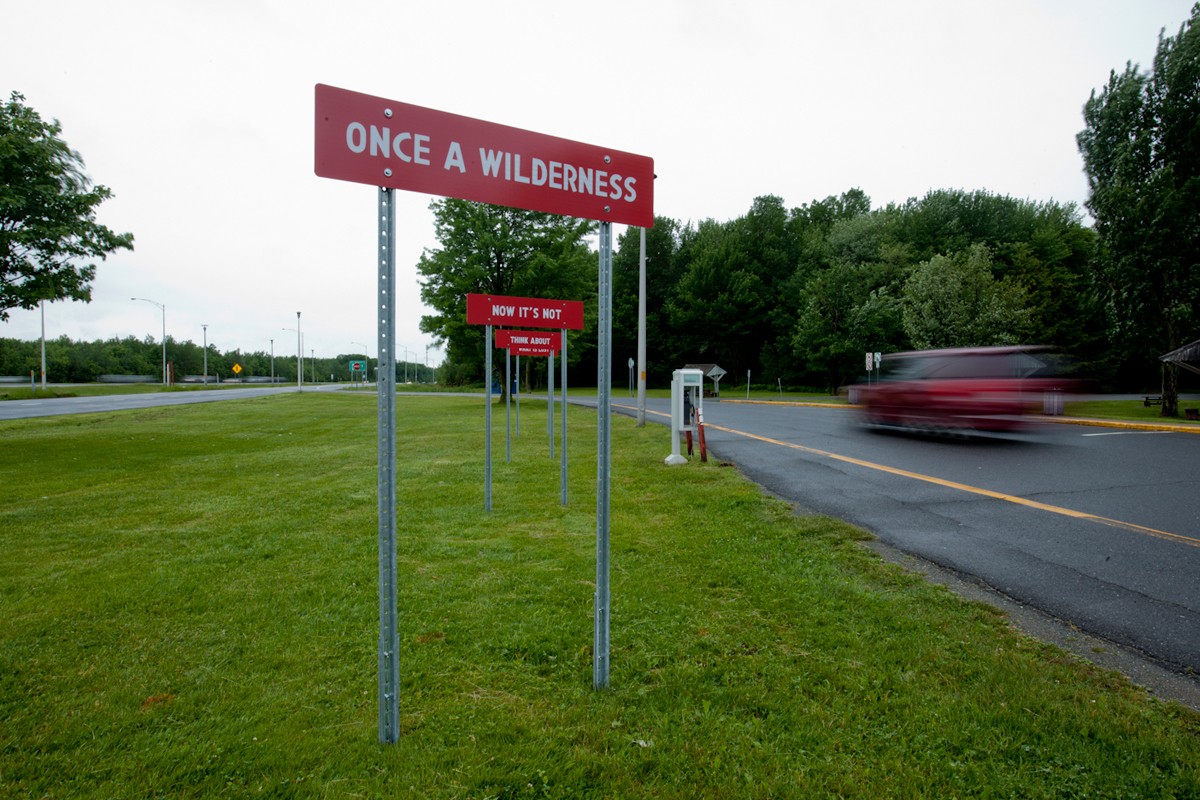 Gisele Amantea’s Vers en bord de route emplaces phrases in Abenaki, French and English. Photo: Charles Frédéric Ouellet.
Gisele Amantea’s Vers en bord de route emplaces phrases in Abenaki, French and English. Photo: Charles Frédéric Ouellet.
Distributed across four Quebec highway rest stops, Gisele Amantea’s project Vers en bord de route (Verse by the Side of the Road) comprises several red reflective road signs grouped in fours, with white text in Abenaki, French and English, the area’s historically important languages (the 20 cuts through traditional Abenaki territory).
Referencing old Burma-Shave advertising signage placed along North American highways from the 1920s through the 1960s, the artist’s verses, written using a similar rhetorical approach, question the notion of this area as “empty space.” While the signs are rectangular, not octagonal, the colour red imparts a sense of emergency, or maybe a call for some sort of stoppage—of the erosion of the Abenaki language, perhaps, or of Canadian colonial legislation and attitudes.
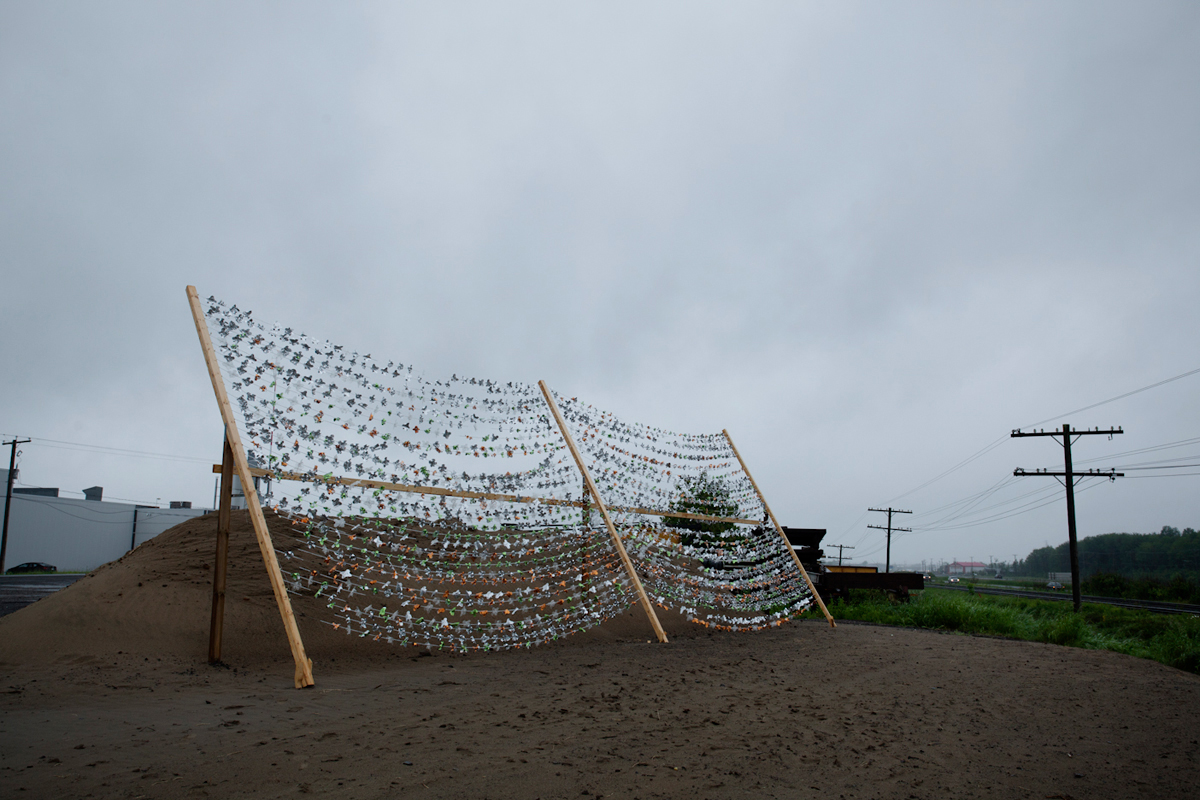 Camille Bernard-Gravel’s project Zénith is a kind of anti-billboard, a large installation composed of a hundred metallic garlands made from multicoloured, reflective plastic flower-shapes. Photo: Charles Frédéric Ouellet.
Camille Bernard-Gravel’s project Zénith is a kind of anti-billboard, a large installation composed of a hundred metallic garlands made from multicoloured, reflective plastic flower-shapes. Photo: Charles Frédéric Ouellet.
Camille Bernard-Gravel’s project Zénith, at Laurier-Station, is a kind of anti-billboard, a large installation composed of a hundred metallic garlands made from multicoloured, reflective plastic flower-shapes stretched across a large bamboo armature. Tilted toward the Montreal-bound traffic, the thousands of “flowers” flash brightly in the sun and wind.
To a driver on a sunny day, the light show’s source is mysterious, the armature invisible underneath the flashing light. As Zénith is not easily accessible up close, the driver will probably never find out “what that was,” recalling French theorist Paul Virilio’s notion of how speed mediates available information, transforming the spaces passed through from places into brief regions in time.
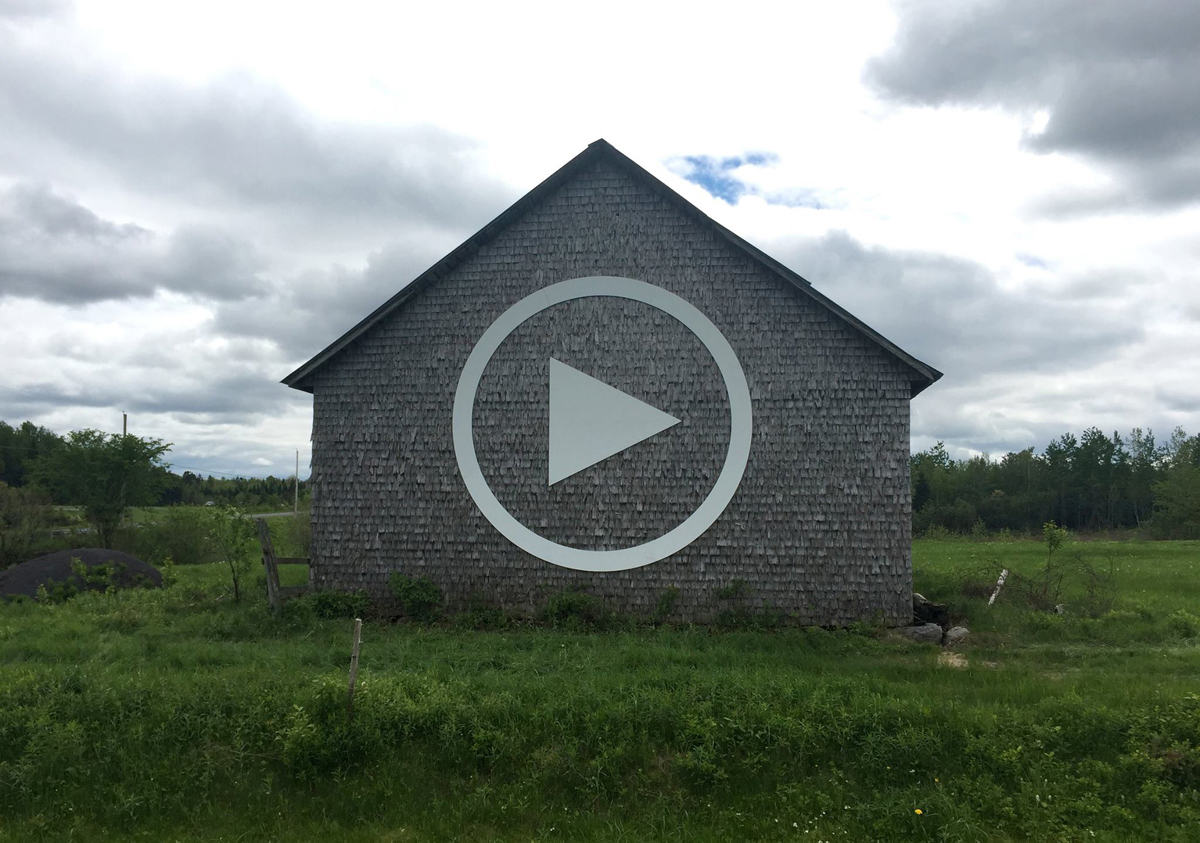 Patrick Bérube” width=”1200″ height=”800″ />Patrick Bérube’s project Se jouer du reel—Play Reality installs a video-play graphic on the side of an old barn. Photo: Richard Berube.
Patrick Bérube” width=”1200″ height=”800″ />Patrick Bérube’s project Se jouer du reel—Play Reality installs a video-play graphic on the side of an old barn. Photo: Richard Berube.
Patrick Bérubé’s project Se jouer du reel—Play Reality makes the idea of speedy travel as a mediated space even more explicit. A gigantic circled triangle—like a YouTube video “play” symbol—installed on the side of an ancient, grey-shingled barn, Play Reality seems to suggest that we might simply reach toward objects as they arise along the roadside, activating or animating them.
Bérubé’s execution is a reminder, poetic in its simplicity, that highway driving is in essence a cinematic experience, with the windshields functioning as screens (another Virilio idea).
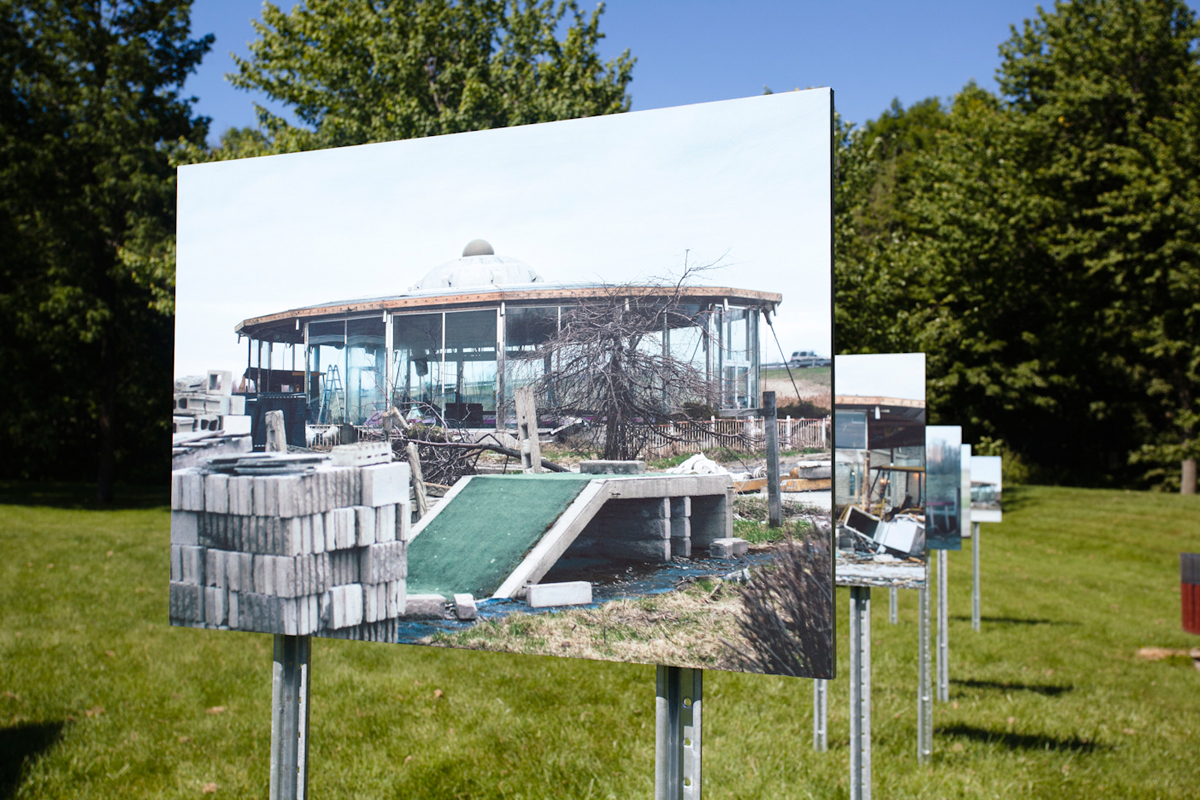 Artist duo Gagnon–Forest (Mathieu Gagnon and Mathilde Forest) highlight the decayed creations of a visionary Quebec inventor in Avant la fin: Les ruines du parc d’attractions de l’inventeur québécois Jean Saint-Germain. Photo: Charles Frédéric Ouellet.
Artist duo Gagnon–Forest (Mathieu Gagnon and Mathilde Forest) highlight the decayed creations of a visionary Quebec inventor in Avant la fin: Les ruines du parc d’attractions de l’inventeur québécois Jean Saint-Germain. Photo: Charles Frédéric Ouellet.
Avant la fin: Les ruines du parc d’attractions de l’inventeur québécois Jean Saint-Germain (Before the End: Ruins of Quebec Inventor Jean Saint-Germain’s Theme Park), a project by artist duo Gagnon–Forest (Mathieu Gagnon and Mathilde Forest), redirects us to the notion of place. Five photo panels depict the ruins of Jean Saint-Germain’s circular glass restaurant and of the robot servers that attended its customers.
An homage to this idiosyncratic patenteux (tinkerer) and his theme park, which was located not far from the exhibit location (the Saint-Nazaire d’Acton rest stop), Avant la fin is also a lament that such local examples of “alternative patrimony,” so unique and beloved, are not preserved.
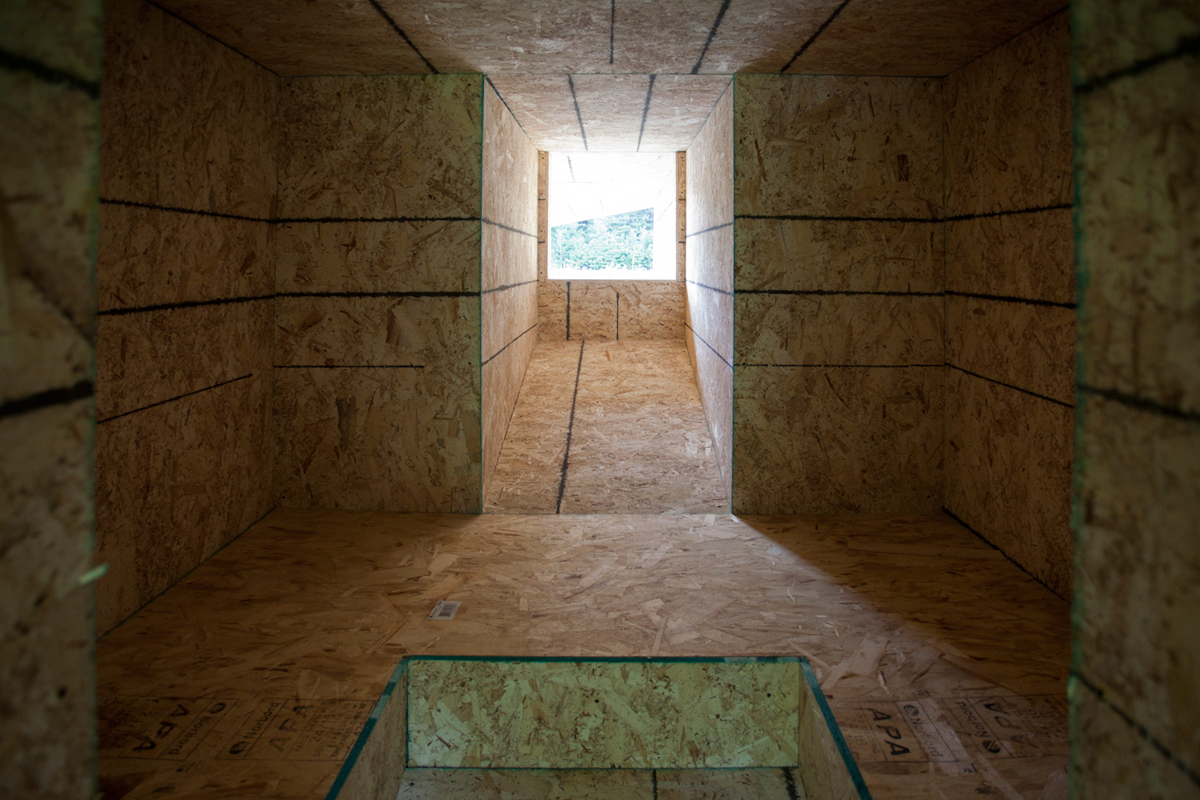 Nicolas Fleming’s La promesse d’un future is a small cabin constructed plywood panels. Photo: Charles Frédéric Ouellet.
Nicolas Fleming’s La promesse d’un future is a small cabin constructed plywood panels. Photo: Charles Frédéric Ouellet.
Nicolas Fleming’s La promesse d’un future (The Promise of a Future) is a small cabin constructed from oriented strand board (OSB) panels, along with antique doors and windows. The latter, though impractical—doors that won’t open, blocked windows—remind us of the pre-OSB past, perhaps in nostalgia for a time before things got so, well, industrial.
Going around back, visitors may enter the cabin via a narrow, upwardly ramped passage. Midway along are alcoves to left and right, not unlike cathedral transepts. Climbing further upward, the visitor may peer out through a small, open window, a tiny holy-of-holies looking out over the autoroute. Fleming’s cabin nods toward what film theorist Edward Dimendberg calls our “centrifugal” society—endless construction zones, unrestricted urban sprawl—and yet, as often happens when artists work in the vocabularies of contemporary architecture, the structure also assumes a sacral or hermetic aspect.
With her installation ExCroissance , Rosalie D. Gagné shifts us from the hermetic toward the imposingly abject. If “Truck Stop” has a flagship project, this is it—a monumental inflatable sculpture of a seemingly organic tube or canal mounted atop Relais Routier Petit, a truck-stop complex near Sainte-Hélène-de-Bagot.
Its situation atop a restaurant evokes digestion, which in turn suggests the economy of consumption served by arteries (another physiological metaphor) like the 20. Impossible to miss, ExCroissance also recalls the North American tradition of monumental kitsch sculptures marking local places and themes.
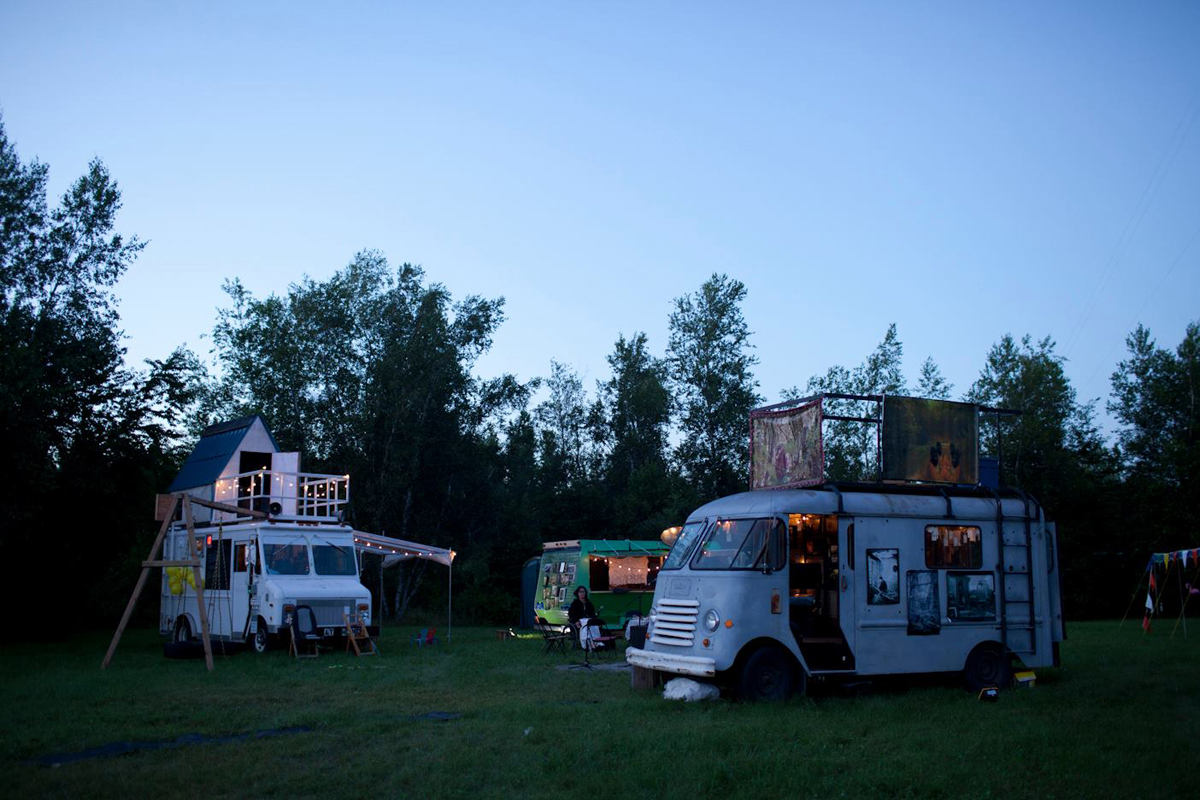 Convoi by L’Orchestre d’hommes-orchestres features mini-exhibits located in cars, trucks and trailers. Photo: via Truck Stop Facebook page.
Convoi by L’Orchestre d’hommes-orchestres features mini-exhibits located in cars, trucks and trailers. Photo: via Truck Stop Facebook page.
Further along, at Notre-Dame-du-Bon-Conseil, the visitor encounters Convoi (Convoy), a project by L’Orchestre d’hommes-orchestres featuring various mini-exhibits located in cars, trucks and trailers by a dozen-or-so participating artists.
The vehicles have been repurposed as exhibition spaces, mini-cinemas, audio stations, and the like, as well as display works that challenge notions of private property. While the vehicles and the works therein are eclectic and diverse, the notion of the “convoy” invokes the power of collective action.
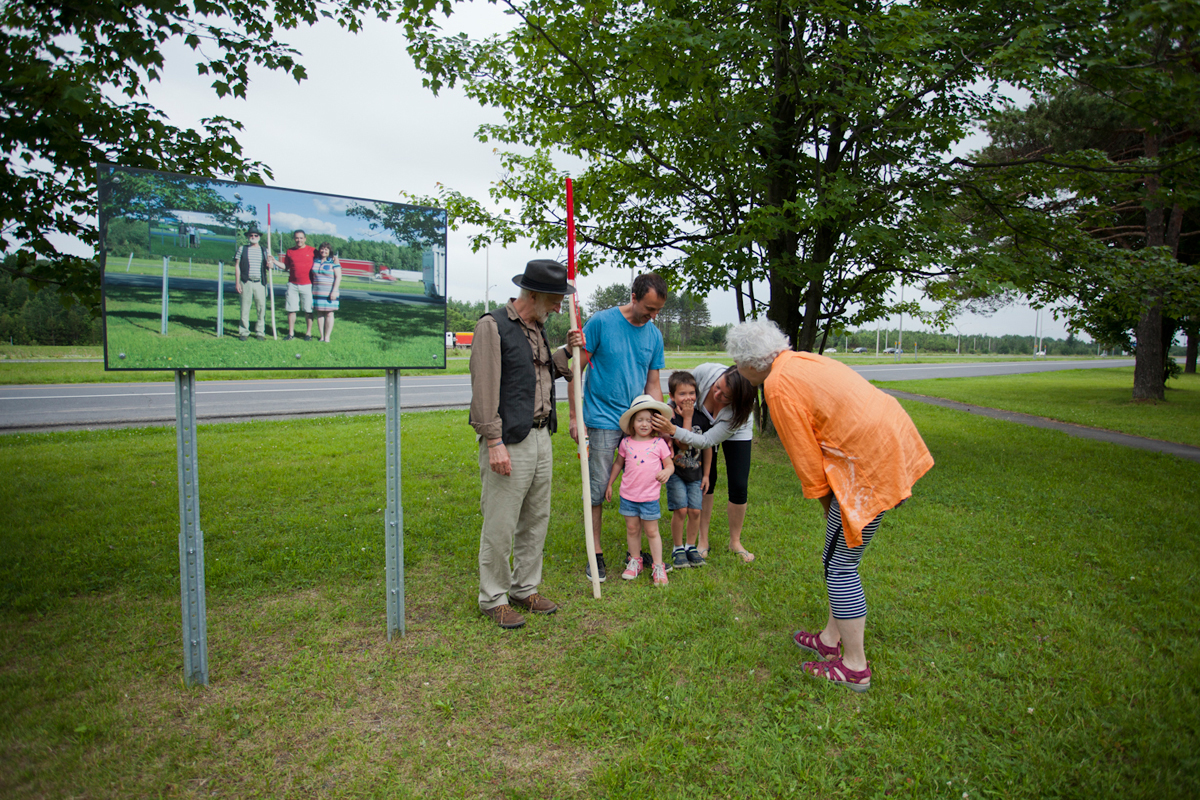 Alain-Martin Richard’s Viens, on va regarder passer les marmottes invites visitors to pose for a photo with the artist. Photo: Richard Bérubé.
Alain-Martin Richard’s Viens, on va regarder passer les marmottes invites visitors to pose for a photo with the artist. Photo: Richard Bérubé.
Alain-Martin Richard’s Viens, on va regarder passer les marmottes (Come, Let’s Watch the Marmots) invites visitors to the Villeroy Nord rest stop to pose for a photo with the artist next to a signboard. Following each of the four shoots (June 16, 21, 30; July 4) a new photo has been installed on the signboard.
With each new photo, the previous photo was moved onto the signboard within the photo, launching participating travellers into an infinite regression via a Droste effect (mise-en-abyme). Perhaps similar to Joseph Campbell’s claim that heroic myths across diverse cultures stem from a surprisingly small set of universal themes, Richard’s work has us consider how living in a car culture—an assembly-line society—may lead to the interchangeability of experience and memory.
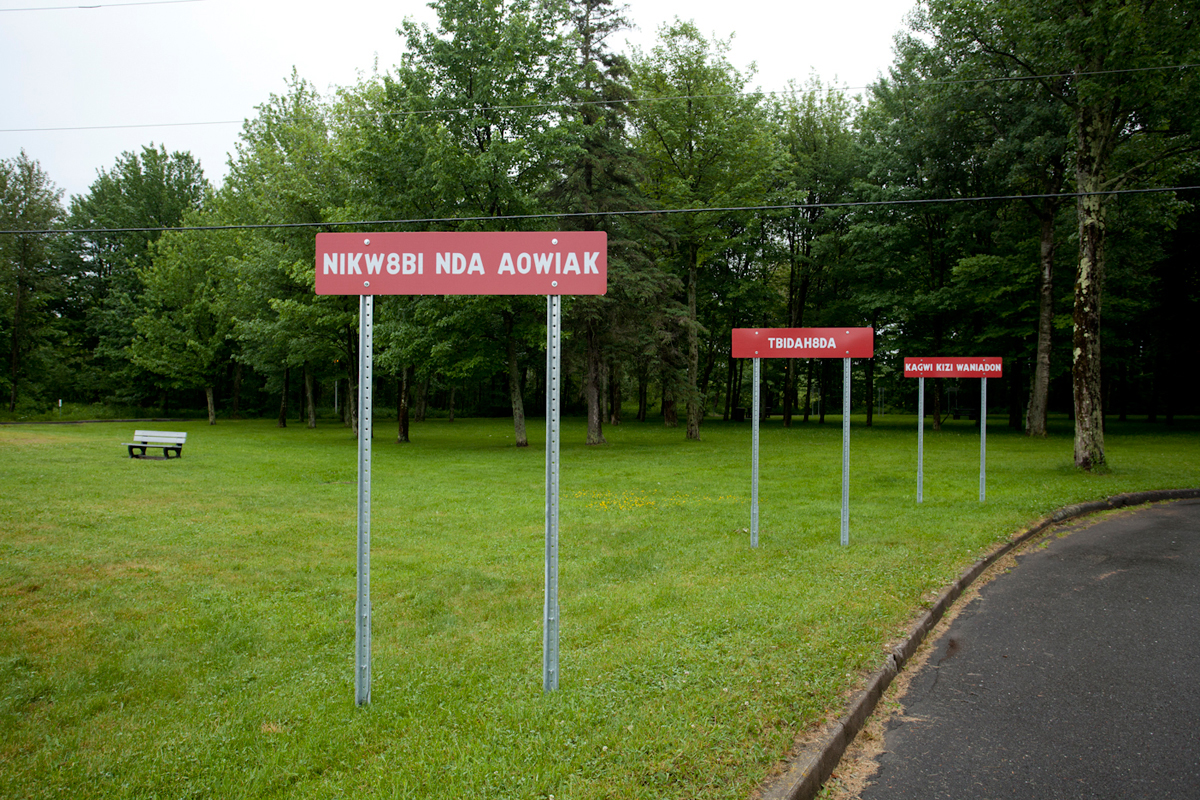 Gisele Amantea’s Vers en bord de route emplaces phrases in Abenaki, French and English. Photo: Charles Frédéric Ouellet.
Gisele Amantea’s Vers en bord de route emplaces phrases in Abenaki, French and English. Photo: Charles Frédéric Ouellet.
As a counterpoint to this motor-orientation, Douglas Scholes is walking from Montreal to Quebec City over Quebec’s “construction holiday,” a two-week period (this year from July 23 to August 5) legislated as an annual holiday for construction workers.
Intercity walking is a rare gesture nowadays, usually reserved for charity fundraising stunts. To conclude the project, the artwork—Scholes himself—will be shipped back to Montreal in an art-transport company’s van, an amusing fling at art commercialization as part of a practically uncommercializable project. Visitors who miss Scholes along the route can follow his progress on the “Truck Stop” website.
Night travellers may also encounter Illumination, a series of nighttime light projections by Organ Mood (Christophe and Mathieu Jacques). For a screen, Organ Mood uses a large grain silo near Sainte-Eulalie.
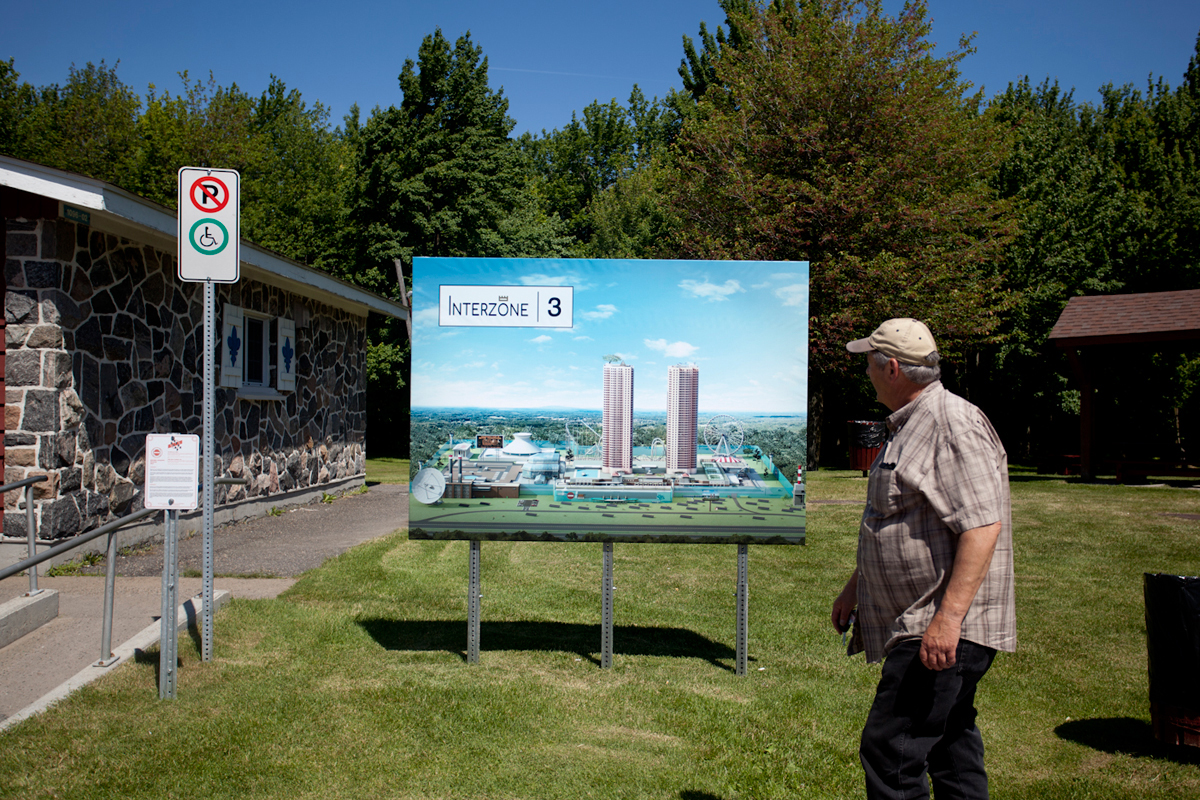 Mathieu Latulippe” width=”1200″ height=”800″ />Mathieu Latulippe’s Interzone 3 reimagines a highway rest stop as a condo and theme park development. Photo: Charles Frédéric Ouellet.
Mathieu Latulippe” width=”1200″ height=”800″ />Mathieu Latulippe’s Interzone 3 reimagines a highway rest stop as a condo and theme park development. Photo: Charles Frédéric Ouellet.
Not far east of Greater Montreal is Mathieu Latulippe’s Interzone 3, a comical reimagining of the Halte des Hurons rest stop as an excessive condo-and-theme-park development concept.
Digitally composed and mounted on a large panel similar to on-site condo development ads, the proposed complex includes a bizarre range of “attractions,” including a rollercoaster, an ancient-Greek-style temple, a massive satellite dish (bigger than the temple), a greenhouse recalling the 1851 Great Exhibition’s Crystal Palace, prison-style guard towers and three tennis courts. In appropriating the visual language of urban developers, Interzone 3 also conveys what sometimes appears to be the developer’s philosophy—something between why-the-fuck-not and because-we-can. As the visitor approaches Montreal via Beloeil, Boucherville and Longueuil, the consequences of this philosophy—asphalt, malls, sprawl, exhaust—come into focus.
steven girard – a qui de droit – truck/stop – phase 04 from St Girard on Vimeo.
Two online projects are available on the “Truck Stop” website. Ariane Plant’s Ici, jaillissent les oiseaux (Here, the Birds Burst Forth) is an audio journey along the 20 featuring synthesized elements, birdsong, human voices and motor sounds—and occasionally, human voices mimicking motor sounds. This lengthy work (two-and-a-half hours) demands long attention, a welcome counterpoint to the highway’s emphasis on speed.
Steven Girard’s À qui le droit (To Whom the Right) is an unfolding series of video performances in which the artist-protagonist flees his identity as he travels the highway between Montreal and Quebec.
“Truck Stop” finishes up on August 19 with a presentation of Nelly-Ève Rajotte’s monumental video installation Blanc (White) at Ciné-Parc, a disused drive-in theatre in Drummondville. Rajotte regularly films images of this abandoned cinema using a drone-mounted camera. Viewers are advised to expect destabilization and vertigo, as the drone-camera flies over the giant screen and its local environs.
As a means to reach new publics and achieve unexpected encounters, “Truck Stop” is quite successful, attracting two categories of visitor.
The first category is art lovers, who will drive one way down the highway, then back again, stopping where possible to examine the works. For this group, and like a really long road movie, “Truck Stop” is a time-based art form requiring a commitment of eight to ten hours. The efforts made at curatorial control (always imperilled with any exit from the white cube) include interpretive panel at each exhibit, and 80,000 diner-style placemat map-guides distributed to restaurants along the route.
The second, much larger category comprises the thousands of casual drivers who encounter the works accidentally (mostly) as they drive past or pause at rest stops. This group is less likely to read the panels or map—but this, too, can yield worthwhile results: surprise, wonder, delight, discombobulation.
For those who don’t read the project texts—and sometimes, for those who do—the line between what is and isn’t art is easily blurred. That old billboard, for example, comprised of nine plywood panels in varied shades of faded green on the southern roadside west of Drummondville—is it a persistent ruin or a gorgeous formalist study? Or the giant board on the north side near Sainte-Hélène-de-Bagot with the pink-and-purple-pigtailed girl sticking out her tongue—seriously, WTF?!
Encounters like these aren’t part of the show—yet in a way they are, as together they form a background for the curated works. Since the gallery, here, is the highway itself, bringing a map may be useful. But it can also be fun to burn the map and just see what happens.
Edwin Janzen is a writer, editor and interdisciplinary artist working in digital print, video and artist books. Born in Winnipeg, he completed his MFA at the University of Ottawa, and he currently lives and works in Montreal.

